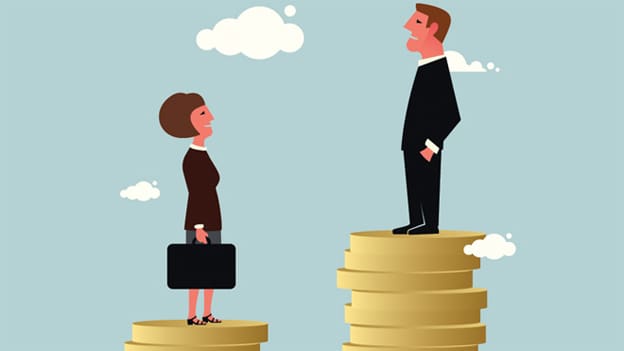Now Reading: Gender Pay Gap : An Unconscious Discrimination
-
01
Gender Pay Gap : An Unconscious Discrimination

Gender Pay Gap : An Unconscious Discrimination
Britannica defines Discrimination as “the intended or accomplished differential treatment of persons or social groups for reasons of certain generalized traits. The targets of discrimination are often minorities, but they may also be majorities, as black people were under apartheid in South Africa.”
A number of terms have been coined as the society progressed, so are its methods to discriminate. Terms such as racism, sexism, anti-Semitism, homophobia, transphobia, or cissexism (discrimination against transgender persons), classism (discrimination based on social class), lookism (discrimination based on physical appearance), and ableism (discrimination based on disability) have found its very existence among us.
One of the Socio-psychological reason behind Discrimination finds its genesis in Social Identity Theory where an individuals belonging to a more prestigious and powerful group than others finds greater boost in morale and confidence that the rest of the others belonging to less powerful group. Further, Discrimination that allows debasing and resultant deprivation of individuals belonging to less popular groups, of wealth and other resources by those belonging to powerful and prestigious groups gives them a sense of strengthening their group and indirectly serves as boost to the self-esteem and self-worth of the individuals of the powerful group.
Although Discrimination contributes only a small part towards the gender pay gaps in India and the World.
According to latest report of World Economic Forum on Global Gender Pay Gap 2020, the Global Gender Pay Gap score (based on the population-weighted average) stands at 68.6%. This means that, on average, the gap is narrower, and the remaining gap to close is now 31.4%. While no country has yet managed to achieve full gender pay parity, the top 5 countries managed to close the gender pay gap by 80% with Iceland being the best performer for consecutive 11 years with gender pay gap closing by a score of 82%, while India stands at 112th Rank with an index score of 35.4%.
Among the 10 best performers on this subindex, four are from Sub-Saharan African (Benin has closed so far 84.7% of its Economic Participation and Opportunity gap; Burundi 83.7%; Zambia, 83.1% and Guinea, 80.3%); one is from Western Europe (Iceland, 83.9%); one is from East Asia and the Pacific region (Lao PDR, 83.9%); two are from Eastern Europe and Central Asia (Belarus, 83.7%, and Latvia, 81.0%); and two are from the Latin America and the Caribbean region (the Bahamas, 83.8%, and Barbados 80.8%). At the other end of the spectrum, economic opportunities for women are extremely limited in India (35.4%), Pakistan (32.7%), Yemen (27.3%), Syria (24.9%), and Iraq (22.7%).
In 1950s, the women, whether living in Asia or Europe or the United States, we’re often not educated and had not finished their college degree and not even been in one. Resultantly they come down to employed in menial jobs and grouping in Feminine Industries.
Many factors responsible for the Gender Pay Gap were: Lower female Education Rate, Lower workforce participation of Women, Grouping in Traditionally Feminine Industries, the practice of Discrimination being completely Legal, and such other cultural norms like Women are less intelligent, Women cant hold power, Women should be HOMEMAKER, Women should raise children. Over the decades, things changed through various liberation and revolutionary movements. Many factors and cultural discrimination factors shrunk except for ONE: Women should raise children and is supposed to be a homemaker. This idea was prevalent in U.S., U.K., and even in progressive European countries. While when it comes to men, the majority of the population, even today, believes that newly become father should work full time. This is the Heart of the Pay Gap: unconscious discrimination.
It seems Gender Pay Gap isn’t so much for being a woman but for being a ‘Mother’. It is therefore essential to change how we as a society look or perceive of women. The unconscious discrimination directly hits a sharp blow at the participation rates of women in the employment field. As a result, lesser participation due to maternity breaks, sabbatical required for family care, sick parents, etc. decreases leading to lesser promotions and a rise in an average gender pay gap.
According to the ‘Progress of the World’s Women 2019-2020’ report by United Nations Women, there are an estimated 13 million households run by single mothers while single fathers are far less constituting only to a small percentage. There is a lack of any cogent data on single fathers in India as the concept itself is rare.
In the US the number of single mothers is 3 times the number of single fathers, thus the majority of the children of single mother grows up learning that women are the caregivers. The roots of this issue go deep on how we understand FAMILY and mothers and fathers and that’s why the gap is so difficult to close.
While, Women in U.S. who do not wish to have children earns 96% to the men.
TALE OF TWO COUNTRIES: Iceland and Rwanda
Rwanda:
The two countries almost closed their wage gaps in just a few decades. Rwanda is a poorest country on the globe and few decades ago, women were denied of their basic rights such as Right to vote or even to speak in public or to open a bank account without the authorization of her husband. In 1994, everything changed in Rwanda. The days of carnage and bloodshed in this central African country swept more than half of the male population. In just the span of 3 months 800,000 of people were dead leaving the country with 70 to 80 percent of female population. Thus in order to rebuilt Rwanda, the participation of women became crucial. What started as a survival technique post genocide became the sole reason for bringing the equality of men and women in society and thus closing of the gender pay gaps. This had not only torned apart the traditional social fabric in totality but changed the very mindsets of the masses to combat the plague of ‘Female are Homemakers’ mentality. Women are later elected and allowed seats in parliament, in Naval and armed forces, in professions like Doctors, Engineers, lawyers, etc. which were earlier traditionally captured by males. Today, Rwanda has almost closed the Gender Pay Gap as each woman in the country makes 96% on a dollar a man makes. A host of new aggressive policies were introduced post genocide, including Monitoring mechanism to ensure gender equality. The new Preamble to the Constitution of Rwanda included commitment to Equal rights for both men and women making atleast a 30% participation of women at all levels of Government. Today, women in Rwanda holds 61% of the total seats in the Parliament, being the highest in the world.
Iceland:
In 1975, Iceland faced a major revolution from women across the country against the existing pay gap despite an adequate participation rate. The entire wave of revolution lead to dire scarcity of workforce in both organised and unorganised sector. This came as a turning point where women made themselves as a visible section of the society putting across demands and objecting to gender disparity. Resultantly, in 1980, Iceland welcomed its first democratically elected female President Ms. Vigdís Finnbogadóttir. In years to follow, a host of policies were introduced to boost both female participation in workforce as well as to establish pay parity. In 1981, Iceland for the first time, introduced to the world and made it mandatory for its corporate sector to provide Maternity Leave of 3 months, which was extended to 6 months in 1988. But this progressive law was rather reversing at its grassroot level as it encouraged more mothers to stay at home, strengthening the stereotypes of women being homemakers and responsible for childcare. To combat this, the country introduced mandatory Paternity Leave for newly become father which made the image of both men and women as caregivers and breadwinners. Today Iceland stands at first rank on Global Gender Pay Gap Index by with pay gap shrunk to 82% between men and women.
However the battle is far from being won worldwide and the fight somehow starts with men willing to share the burden of family equally as any gender pay gap holistically diminish the total family income. Thus it is a slap other way around on men as well. Food for thought.
Pallavi Chauhan










